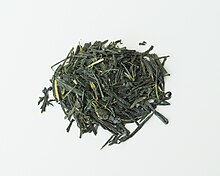Bancha: Difference between revisions
No edit summary |
grammar |
||
| (24 intermediate revisions by 20 users not shown) | |||
| Line 1: | Line 1: | ||
{{Short description|Type of Japanese green tea}} |
|||
{{Unreferenced|date=December 2009}} |
|||
{{Italic title|reason=[[:Category:Japanese words and phrases]]}} |
|||
{{Infobox Tea |
{{Infobox Tea |
||
| Tea_name = Bancha |
| Tea_name = Bancha |
||
| Tea_type = [[Green tea|Green]] |
| Tea_type = [[Green tea|Green]] |
||
| Tea_color = Green |
| Tea_color = Green |
||
| Tea_image = |
| Tea_image = File:Shizuoka bancha.jpg |
||
| Tea_origin = [[Japan]] |
| Tea_origin = [[Japan]] |
||
| Tea_names = Common Tea |
| Tea_names = Common Tea |
||
| Tea_quick = More widely available in [[Western World|the West]]. A late season crop, goes well with food. |
| Tea_quick = More widely available in [[Western World|the West]]. A late season crop, goes well with food. |
||
}} |
}} |
||
'''Bancha''' |
{{nihongo|'''''Bancha'''''|番茶}} is a type of [[Japan]]ese [[green tea]]. It is harvested from the second flush of ''[[sencha]]'' between summer and autumn;<ref>{{Cite web|last=Xenia|first=Blanco|date=Aug 24, 2020|title=Let's talk about bancha!|url=https://www.thejapaneseteahub.com/post/let-s-talk-about-bancha^|archive-url=|archive-date=|access-date=|website=The Japanese Tea Hub}}{{Dead link|date=May 2021 |bot=InternetArchiveBot |fix-attempted=yes }}</ref> the first flush is harvested for ''[[shincha]]''. |
||
It can be found in a number of forms such as roasted, unroasted, smoked, matured or fermented for three years and even post-fermented. For example, [[goishicha]]. |
|||
==Background== |
==Background== |
||
Bancha is harvested from the same tree as ''sencha'' grade, but it is plucked later than ''sencha'' is, giving it a lower market grade. |
Bancha is harvested from the same tea tree as ''sencha'' grade, but it is plucked later than ''sencha'' is, giving it a lower market grade. It is considered to be one of the lowest grades of Japanese green teas.<ref>{{Cite book|last=Tsuji|first=Shizuo|title=Japanese Cooking: A Simple Art|publisher=Kodansha International|year=2007|isbn=978-1568363882|location=Japan|pages=332}}</ref> There are 22 grades of ''bancha''. Its flavour is unique and varies depending on the type. |
||
==Brewing== |
|||
Infuse at approximately 80 degrees Celsius (176 degrees Fahrenheit) – this can be achieved by using an [[electric water boiler]] with an 80-degree setting, or by adding to the boiling water one third of its volume of room temperature water before adding the leaves. Infusing at a higher temperature will cause the tea to taste bitter. Allow the tea to infuse for 30 seconds to 3 minutes. |
|||
<!-- ---------------------------------------------------------- |
|||
See http://en.wikipedia.org/wiki/Wikipedia:Footnotes for a |
|||
discussion of different citation methods and how to generate |
|||
footnotes using the <ref>, </ref> and <reference /> tags |
|||
----------------------------------------------------------- --> |
|||
{{reflist}} |
|||
| ⚫ | |||
Flavours range from smoke, roasted nuts, green grass, earth, soil, wet leaves, some of the types of bancha have a stronger straw smell. |
|||
==See also== |
==See also== |
||
* [[ |
* [[Hōjicha]] – often made from bancha |
||
* [[Japanese tea]] |
* [[Japanese tea]] |
||
* [[Tea Culture in Japan]] |
|||
== References == |
|||
| ⚫ | |||
<references /> |
|||
[[Category:Green tea]] |
|||
{{Japanese food and drink}} |
|||
| ⚫ | |||
| ⚫ | |||
{{Tea-stub}} |
|||
{{Japan-cuisine-stub}} |
|||
Latest revision as of 17:45, 26 April 2024
| Bancha | |
|---|---|
 | |
| Type | Green |
| Other names | Common Tea |
| Origin | Japan |
| Quick description | More widely available in the West. A late season crop, goes well with food. |
Bancha (番茶) is a type of Japanese green tea. It is harvested from the second flush of sencha between summer and autumn;[1] the first flush is harvested for shincha.
It can be found in a number of forms such as roasted, unroasted, smoked, matured or fermented for three years and even post-fermented. For example, goishicha.
Background
[edit]Bancha is harvested from the same tea tree as sencha grade, but it is plucked later than sencha is, giving it a lower market grade. It is considered to be one of the lowest grades of Japanese green teas.[2] There are 22 grades of bancha. Its flavour is unique and varies depending on the type.
Flavours range from smoke, roasted nuts, green grass, earth, soil, wet leaves, some of the types of bancha have a stronger straw smell.
See also
[edit]- Hōjicha – often made from bancha
- Japanese tea
- Tea Culture in Japan
References
[edit]- ^ Xenia, Blanco (Aug 24, 2020). "Let's talk about bancha!". The Japanese Tea Hub.[permanent dead link]
- ^ Tsuji, Shizuo (2007). Japanese Cooking: A Simple Art. Japan: Kodansha International. p. 332. ISBN 978-1568363882.
